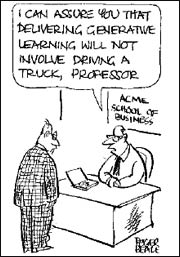Too much content is delivered out of context
Roula Khalaf, Editor of the FT, selects her favourite stories in this weekly newsletter.
Today’s globally-integrated and digitally-mediated market economy places a premium on innovation, new business models and networked ways of organising work.
To survive and thrive in this hyper-competitive environment, the modern-day enterprise must focus on driving top-line growth via relentless innovation that is focused squarely on delivering customer value.
As a result, today’s employees need a different set of capabilities from previous generations if they are to flourish in the workplace. They need to be able to maintain a broad perspective as they survey the global business landscape, as well as the ability to dive into the details when necessary.
In short, they need to be “and” people: intuitive and logical, visionary and operational, qualitative and quantitative, market focused and financially flawless.
Organisations naturally look to traditional seats of learning to provide this new generation of employees. After all, universities and, more recently, business schools have been delivering learning since their inception.

However, the kind of learning the modern business professional requires is a far more complicated phenomenon than can ever be limited to the classroom.
Business schools today have invested too much in conveying knowledge about tasks they know how to do – productive learning – and under-invested in developing and sharing insights about tasks they do not as yet understand – generative learning.
While productive learning is the domain of study programmes that teach topical content, generative learning focuses on engaging students in authentic situations that enable them to grasp an over-arching business context. These two types of learning have different philosophical foundations. Productive learning is professionally instructed, while generative learning is rooted in situations.
To date, business schools have largely focused on productive learning. In recent years, this predisposition has been further amplified by the introduction of e-learning technologies, which increase the efficiency of content delivery.
However, as the delivery of productive learning content becomes more efficient, business schools must recognise that this efficiency carries a cost. With each delivery of the content – from discipline to curriculum to course to class to topic – the contextual narrative that binds it together is stripped away.
In the quest to improve on their efficient delivery of productive learning, business schools have not only ignored the critical need to focus on generative learning, but have also actually undermined it. While institutions may well be producing the necessary content, they are increasingly delivering it out of context.
Instead of creating more content “dots” for students to consume, business schools need to focus on helping students to “connect the dots” by helping them to make sense of the overall business context in which the modern-day enterprise competes and creates value In short, business schools do not need to create more content but instead need to produce more situational business contexts.
To build the business leader needed today, business schools must become more innovative in blending content and context. Other professional schools, teaching subjects such as medicine and law, have paved the way in understanding how to close the knowing-doing gap by effectively blending the classroom with the operating room and the courtroom.
In order for what is taught in business school to remain relevant to those in the corporate boardroom the schools need to follow this lead by adding more generative learning to their portfolio.
Business school leaders need to “think outside the classroom”. Not doing so could result in their institutions becoming captive to their own limiting paradigms and marginalising their stakeholder value to the point of their own extinction.
Tony O’Driscoll is a professor at Fuqua School of Business, Duke University and is executive director of Fuqua’s Center for Technology, Entertainment and Media.
Comments